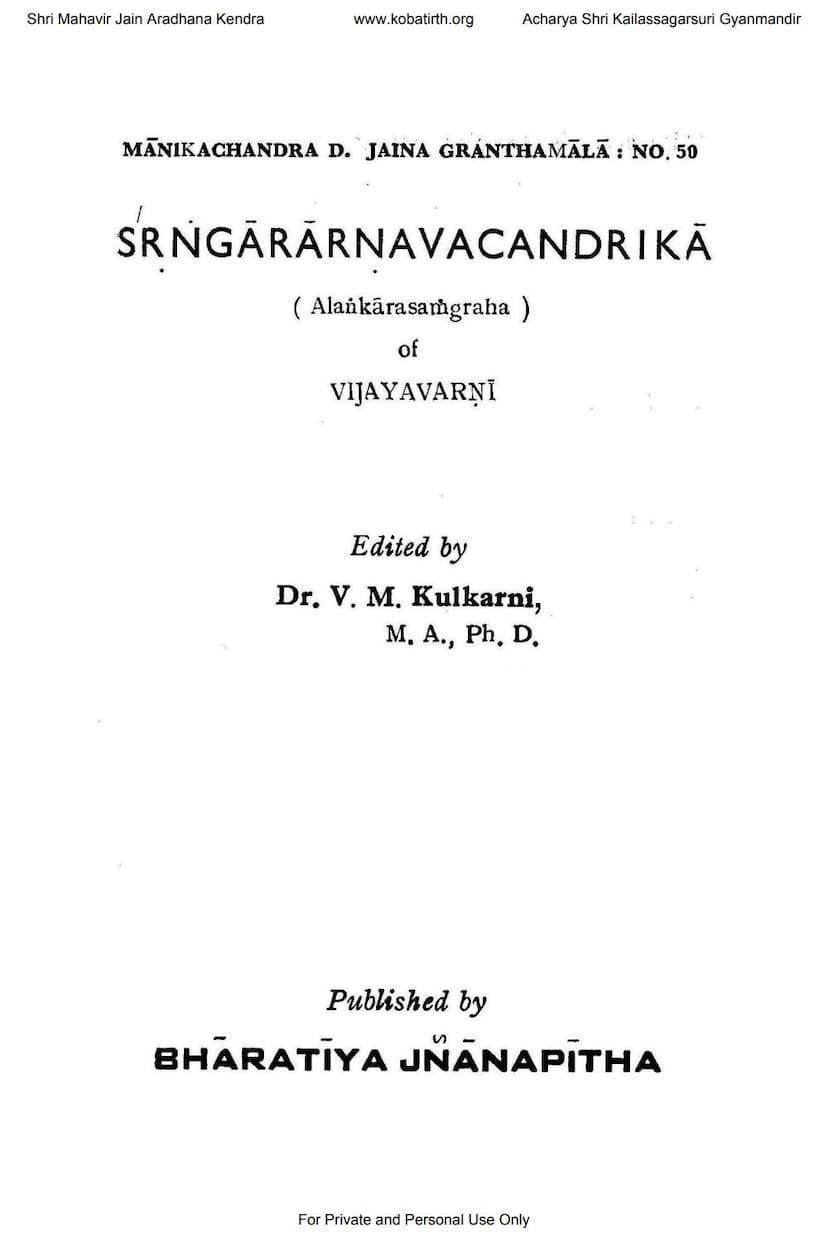Sringar Nav Chndrika
Added to library: September 2, 2025

Summary
Summary of "Śṛṅgārārṇavacandrikā" by Vijayavarṇī
"Śṛṅgārārṇavacandrikā" (ŚC), also known as "Alaṁkārasaṁgraha," is a hitherto unpublished work on Sanskrit poetics authored by Vijayavarṇī, a disciple of Munindra Vijayakīrti. It was composed at the behest of King Kāmirāja of Bangavādi, who is believed to have flourished in the late 13th century CE.
Key aspects of the work and its edition include:
-
Subject Matter: The book is a comprehensive treatise on poetics (Alaṁkāraśāstra), covering various facets of Sanskrit literature. It delves into elements such as the analysis of letters and metrical feet, the nature of words and their meanings, emotions (rasa) and their manifestations (bhāva), character archetypes (hero and heroine), poetic qualities (guṇa), styles (rīti and vrtti), literary devices (alamkāra), and poetic defects (doṣa).
-
Author and Patronage: Vijayavarṇī, who also identified himself as 'Kaviśvara' and 'Kavisaktibhāsura', composed the work to explain the principles of poetics to King Kāmirāja. The work is notable for its use of original examples, all of which are composed by Vijayavarṇī himself and serve to glorify King Kāmirāja. This approach is similar to other renowned works on poetics like Jagannātha's "Rasagaṅgādhara" and Vidyānātha's "Pratāparudrayaśobhūṣaṇa."
-
Date of Composition: Based on the patronage of King Kāmirāja, who ascended the throne in 1264 CE, Vijayavarṇī is estimated to have composed the ŚC in the last quarter of the 13th century CE. However, comparative studies with other works suggest a need for further evidence to definitively establish the date.
-
Structure and Content: The ŚC is divided into ten chapters, each dedicated to a specific aspect of poetics:
- Varṇa-gaṇa-phala-nirṇaya: Analysis of letters, metrical feet, and their auspicious or inauspicious effects.
- Kāvya-gata-śabdārtha-niścaya: Study of words, their meanings, and the classification of poets.
- Rasa-bhāva-niścaya: Detailed exposition of emotions (rasa), their states (bhāva), and associated elements like Vibhāvas, Anubhāvas, Sattvika-bhāvas, and Vyabhicāri-bhāvas. It also discusses the colors and presiding deities of rasas.
- Nāyaka-bheda-niścaya: Classification of heroes and heroines, their types, companions, and the various emotional states of heroines.
- Daśa-guṇa-niścaya: Discussion of ten poetic qualities (guṇa).
- Rīti-niścaya: Examination of poetic styles (rīti).
- Vṛtti-niścaya: Analysis of dramatic presentations or styles (vrtti).
- Śayyā-pāka-niścaya: Study of the "mutual suitability of words" (śayyā) and the "ripeness" of meaning (pāka).
- Alaṁkāra-nirṇaya: A comprehensive catalog of 47 semantic figures of speech (arthālaṁkāra), with definitions and classifications, drawing heavily from Dandin and Rudrata.
- Doṣa-guṇa-niścaya: Detailed analysis of poetic defects (doṣa) affecting words, sentences, and meanings, and also exploring circumstances where these defects transform into qualities. This section closely follows Mammata's "Kāvyaprakāśa."
-
Sources and Influences: Vijayavarṇī demonstrates a thorough study of classical works on poetics by authors like Dandin, Vamana, Dhananjaya, Mammata, Rudrata, and Vidyānātha. While his definitions are often based on these predecessors, his work also exhibits specific nuances, such as the Jaina interpretation of Śānta-rasa and the mention of "Para-Brahma" as its presiding deity. The work also shows a notable resemblance to "Alamkārasaṁgraha" by Amṛtānandayogin, suggesting a potential borrowing between the two.
-
Editorial Merit: The present edition, published by Bharatiya Jñānapītha, is based on a single manuscript discovered by Dr. A. N. Upadhye and meticulously edited by Dr. V. M. Kulkarni. The editor has provided a critical introduction, a detailed table of contents, and several appendices, including lists of verses and passages from earlier works, making it a valuable resource for Indologists and scholars of Sanskrit poetics.
-
Literary Merit: While the work is comprehensive in its coverage of poetics, the editor notes that Vijayavarṇī's poetry, though clear and conventional, might not be considered exceptionally powerful. The value of the work lies more in its systematic presentation of poetics and its contribution to the field, rather than in groundbreaking literary innovation.
In essence, "Śṛṅgārārṇavacandrikā" is a significant contribution to the study of Sanskrit poetics, providing a detailed and systematic exposition of various literary concepts, enriched by original examples and reflecting the intellectual milieu of its time and the patronage it received.